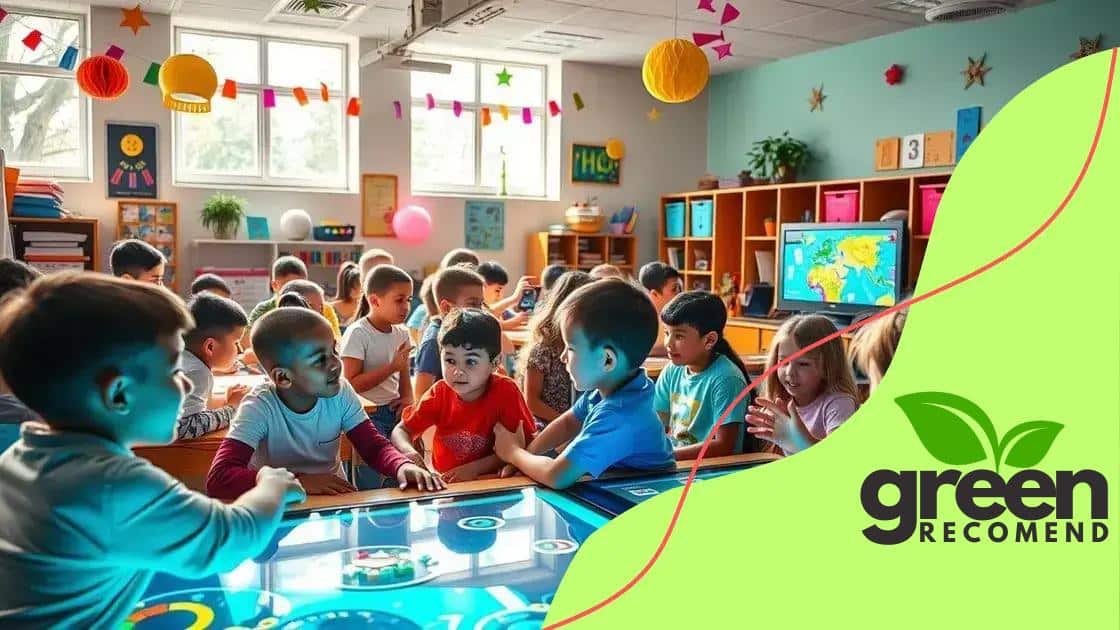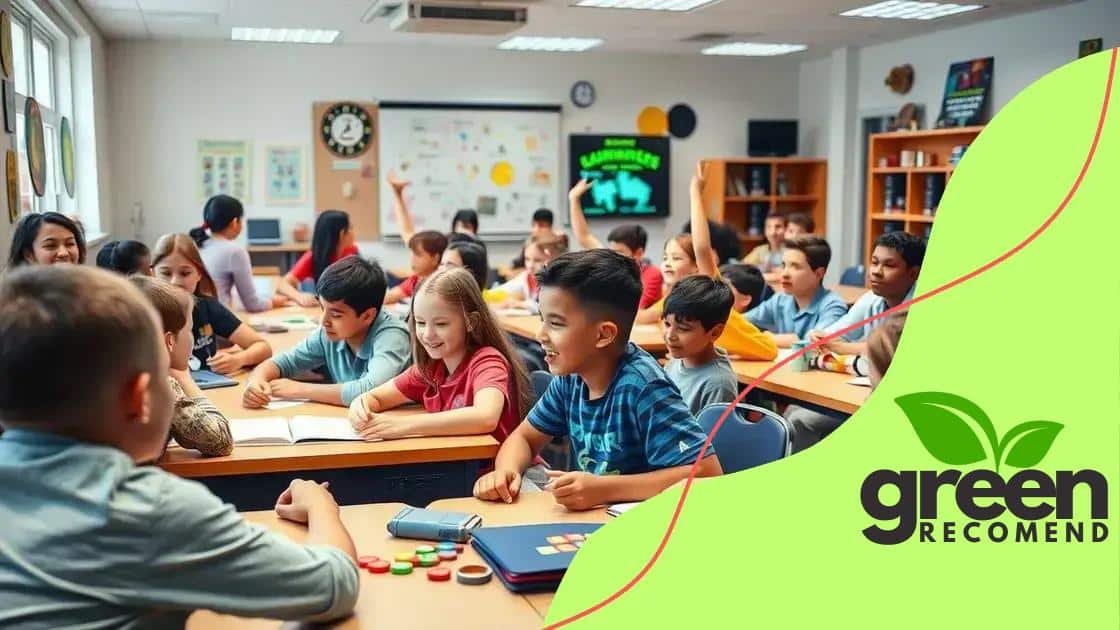Gamification to enhance student engagement in classrooms

Gamification enhances student engagement in classrooms by incorporating game elements like points, badges, and challenges, making learning interactive and enjoyable, which ultimately improves motivation and participation.
Gamification to enhance student engagement in classrooms has become an innovative approach in modern education. It’s intriguing to see how game-like elements can make learning more exciting and interactive for students. What if your classroom could feel like a game that students are eager to play?
Understanding gamification and its principles
Understanding gamification and its principles is key to transforming classrooms. By integrating game elements into learning, teachers can create an engaging environment that motivates students. Let’s explore what gamification is and how it can enhance educational experiences.
What is Gamification?
Gamification involves applying game-design elements in non-game contexts, aiming to improve engagement and motivation. It uses features like points, badges, and leaderboards to make learning more enjoyable.
Key Principles of Gamification
There are several core principles that make gamification effective in education:
- Challenge: Creating tasks that are not too easy nor too hard keeps students engaged.
- Feedback: Providing immediate feedback helps students understand their progress and areas for improvement.
- Rewards: Recognizing achievements through rewards fosters a sense of accomplishment.
- Social Connection: Encouraging collaboration among peers enhances the learning experience.
Incorporating these principles encourages a deeper connection to the material. Students often find it easier to learn when they are actively involved and having fun.
Gamification takes learning beyond traditional methods. Instead of just passing tests, students interact with content, which makes retention easier. They become more invested in their education, leading to better outcomes.
Through the implementation of these techniques, teachers can witness an improvement in overall engagement. Students who might have struggled in a standard setting can thrive in a gamified environment.
Benefits of gamification in education
The benefits of gamification in education are significant and can transform traditional teaching methods. By integrating game elements into learning, students become more engaged and motivated. This approach creates an exciting environment that encourages participation and enhances learning.
Increased Engagement
One of the primary advantages of gamification is the boost in student engagement. When learning feels like a game, students are more likely to participate actively. They become excited about completing tasks and achieving goals.
Improved Motivation
Gamification can also significantly improve motivation among students. Game-like elements, such as challenges and rewards, encourage learners to push themselves. They are more willing to tackle difficult subjects when they see immediate rewards for their efforts.
- Challenges: Setting challenging tasks keeps students focused.
- Rewards: Earning points or badges provides validation for their efforts.
- Competition: Friendly competition can inspire students to perform better.
- Creative Learning: Gamified activities can inspire creativity and innovation.
Moreover, incorporating these elements helps to create a positive atmosphere. When students are actively engaged and motivated, they are more likely to develop a love for learning. This can lead to better academic performance and a deeper understanding of the material.
Gamification also fosters collaboration among peers. Many gamified activities encourage teamwork, allowing students to work together towards common goals. This not only strengthens their learning but also builds essential social skills.
Effective gamification strategies for classrooms

Implementing effective gamification strategies in classrooms can greatly enhance student learning. Educators can apply a variety of methods to make their lessons more engaging and interactive. These strategies not only captivate students but also foster a love for learning.
Create Clear Goals
Setting clear and achievable goals is essential in a gamified classroom. Students should understand what they need to accomplish to earn rewards. Specific objectives allow them to track their progress and feel a sense of accomplishment.
Use a Variety of Game Elements
Incorporating elements like points, badges, and leaderboards can make learning exciting. Here are some key elements to include:
- Points: Award points for completing assignments or participating in class.
- Badges: Create badges for milestones, encouraging students to strive for achievements.
- Leaderboards: Use leaderboards to foster friendly competition among students.
Using a mix of these elements ensures that all students are motivated in different ways. Some may thrive on competition, while others prefer personal accomplishments.
Additionally, incorporating storytelling in lessons can enhance engagement. By framing lessons as adventures or quests, students can immerse themselves in the learning process. This technique can turn mundane tasks into exciting challenges.
Another effective strategy is to create a collaborative environment. Encourage group activities where students work together towards common goals. This can enhance communication and teamwork skills, which are invaluable in and out of the classroom.
Tools and platforms for implementing gamification
There are many effective tools and platforms that help in implementing gamification in classrooms. These resources make it easier for educators to create engaging and interactive experiences for students. By utilizing the right tools, teachers can significantly enhance learning outcomes.
Popular Gamification Tools
Several tools stand out for their features that promote gamified learning experiences:
- Kahoot!: This platform allows teachers to create quizzes that are both fun and competitive. Students can participate using their devices, making learning interactive.
- Classcraft: This tool turns the classroom into a role-playing game. Students create characters and can earn points for positive behavior or academic achievements.
- DuoLingo: Primarily used for language learning, DuoLingo employs gamified elements to make the learning process enjoyable and effective.
- Quizizz: Similar to Kahoot!, Quizizz offers quizzes that students can complete at their own pace, adding a layer of flexibility while maintaining gamified engagement.
These platforms make it easy to integrate game mechanics into lessons. They can transform boring tasks into exciting challenges that stimulate students and provide instant feedback.
In addition to these platforms, many educators use learning management systems (LMS) that support gamification. Platforms like Google Classroom and Moodle allow teachers to add game elements to assignments. For instance, they can set up badges for completing units or offer certificates for mastering skills.
By choosing the right tools, teachers can create personalized learning paths that motivate students. Using analytics provided by these platforms, educators can track progress and adapt their teaching strategies accordingly.
Measuring the impact of gamification on student engagement
Measuring the impact of gamification on student engagement is essential for understanding its effectiveness in educational settings. Educators can use various methods to assess how gamified elements are influencing student participation and motivation. By gathering data, teachers can make informed decisions about their teaching strategies.
Key Metrics to Consider
There are several important metrics that can help gauge the success of gamification:
- Participation Rates: Track how many students are actively participating in gamified activities. Increased participation is a positive indicator.
- Task Completion: Measure the percentage of assignments completed. Higher completion rates suggest that gamification is motivating students.
- Engagement Levels: Use surveys or questionnaires to assess how engaged students feel during gamified activities. Student feedback is valuable.
- Performance Improvement: Compare test scores or project grades before and after introducing gamification. Improved performance can demonstrate effectiveness.
These metrics provide insights into how students respond to gamified learning. By analyzing this data, teachers can identify strengths and areas for improvement.
Another effective way to measure impact is through observation. Teachers can watch how students interact with gamified elements during lessons. Noting their reactions, enthusiasm, and collaboration can also indicate engagement levels.
Additionally, utilizing technology can streamline the data collection process. Learning management systems often come with analytics features that track student activity. This data can be very useful in assessing the overall impact of gamification.
FAQ – Frequently Asked Questions about Gamification in Education
What is gamification in education?
Gamification in education involves integrating game-like elements into learning experiences to enhance student engagement and motivation.
How can gamification improve student participation?
By making learning interactive and fun, gamification encourages students to take part actively in lessons and activities.
What tools are commonly used for gamification in classrooms?
Popular tools include Kahoot!, Classcraft, and Quizizz, which have features designed to boost engagement through games and challenges.
How can I measure the effectiveness of gamification?
You can measure effectiveness by tracking metrics like participation rates, task completion, and student feedback on engagement.





